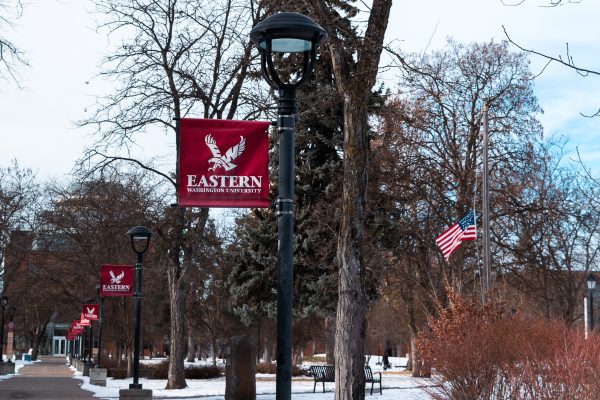Idaho’s Silver Valley, a common epicenter for earthquakes
May 7, 2015
A magnitude 3.9 earthquake hit approximately 36 miles outside of Hayden, Idaho.
The temblor shook the Idaho panhandle on April 23.
A 3.7 earthquake happened first, then the following morning a 3.3 magnitude earthquake, then right before noon there was a 2.7 and that evening there was a 3.9, according to Earthquake Track.
There was another earthquake on April 23 outside of Ponderay, Idaho, according to reports from KHQ news. This earthquake was a 4.2 and caused little damage like the others.
“These are pretty small earthquakes,” said Chad Pritchard, associate professor of geology at EWU.
Pritchard said an earthquake is a pulse of energy released from the movement along a fault line.
These earthquakes originated from the Hope fault named after Hope, Idaho, which Pritchard said is part of the the Lewis and Clark fault zone.
The fault zone runs 30 miles wide and cuts through 240 miles of northern Idaho and northwestern Montana and displays evidence of shearing over the past billion years, according to the Idaho Bureau of Homeland Security. Shearing is how a rock responds to compressive stress and can result in fracturing and simple faults.
Pritchard said these faults all reside in the cordillera, the Spanish term for mountains, which includes the Rocky Mountains but also trails through Mexico and South America.
The western coastline looked a lot different 150 million years ago.
Pritchard said tectonic plates smashed together, increasing the available land, and eventually began relaxing and falling back down.
“If you’re in a sandbox, and you push up a bunch of sand, eventually it’s going to fall back down again,” said Pritchard. “So that’s exactly what’s probably happening here.”
Pritchard said the April 23 and 24 earthquakes were right-lateral, strike-slip faults, where the opposite sides of the fault slide against one another with little vertical movement.
Geologists know this thanks to moment tensor analysis and seismic analysis.
This area of Idaho is known to have earthquakes all throughout the Silver Valley, but Pritchard said whether or not the people living in this fault zone have infrastructure built to withstand earthquakes is debatable.
“They obviously have a higher engineering standard than Sumatra that went through the 2004 earthquake, they don’t have shacks,” said Pritchard. “But I would say it wasn’t really until the 1990s, 1980s, that we really started to actually classify for seismic hazards out here because earthquakes don’t happen very often.”
In Spokane, it was not until the 1980s that they actually planned for 5.0 earthquakes, so older buildings are not really built for it, according to Pritchard.
He said the timing of these earthquakes and the Nepal earthquake is coincidental and that earthquakes are happening all over the world all the time, they are just not always big enough to make national news.
The epicenter of Nepal’s 7.8 earthquake was 50 miles outside of the capital, Kathmandu, according to CNN. And as of Saturday, the casualty toll has gone above 7,000 with at least 14,398 people injured.
According to the Natural Resources of Canada department, earthquakes with a magnitude of 3-4 occur about 100,000 times a year and have an energy release of 1,800 equivalent kilograms of explosives compared to earthquakes with a magnitude around 7, which occur around 20 times a year with an energy release of 1,800,000,000 kilograms of explosives.
“Every time you go up in magnitude it’s like 100, 1,000, 10,000 times larger, so when you get to a 7.0, that’s huge amounts of mass so your buildings are literally shaking and falling down,” said Pritchard.






![Simmons said the biggest reasons for her success this year were “God, hard work, and trusting [her] coach and what she has planned.”](https://theeasterner.org/wp-content/uploads/2024/05/image1-1-1200x800.jpg)










